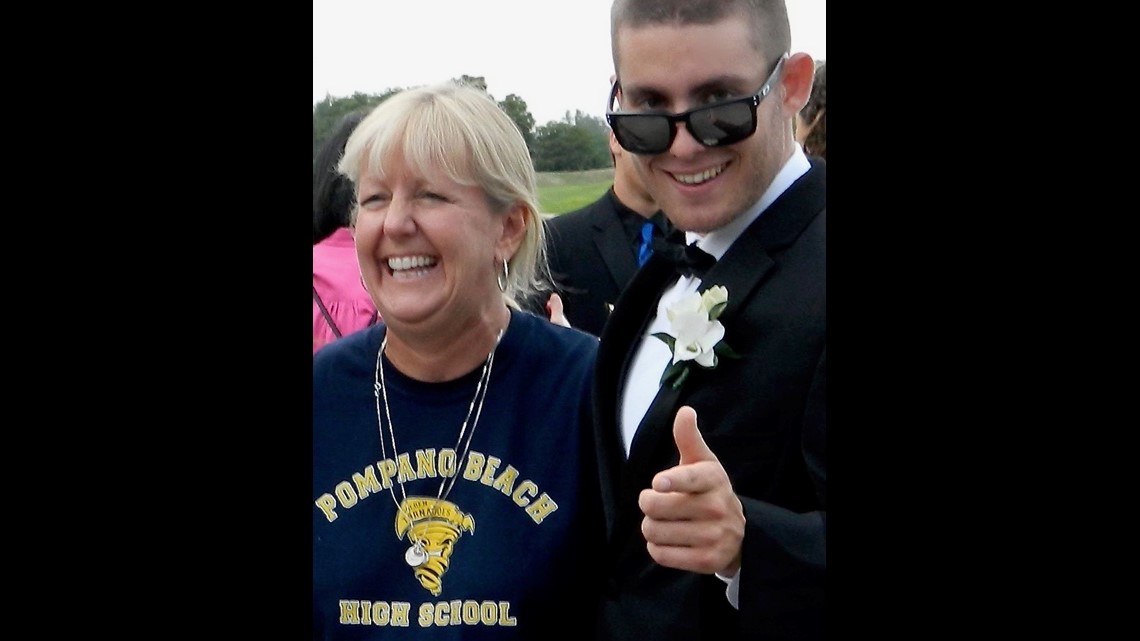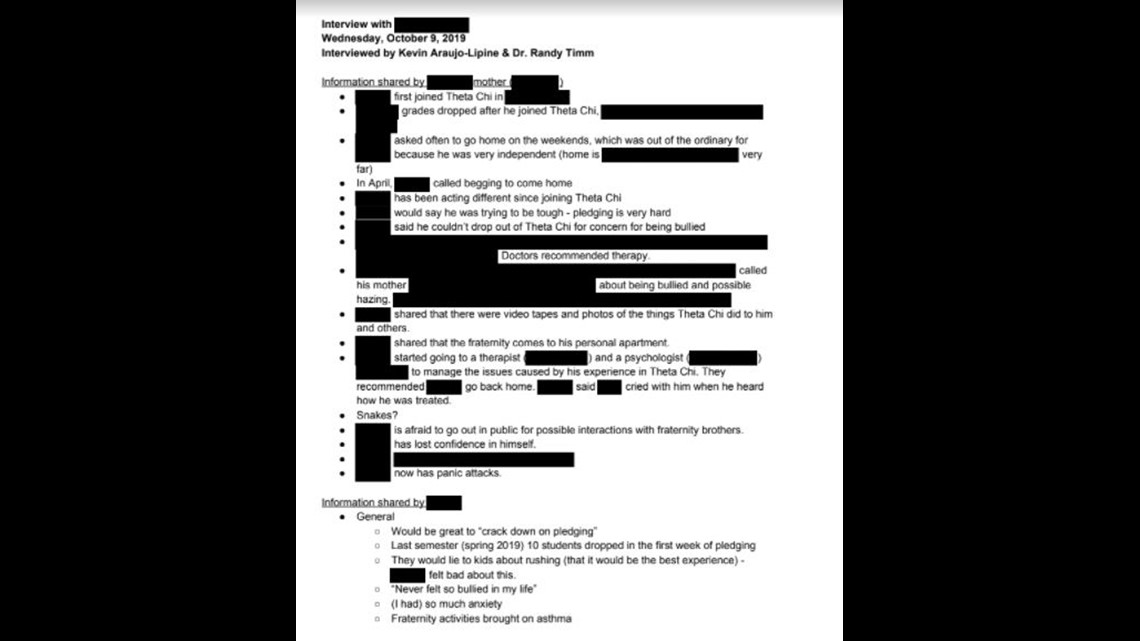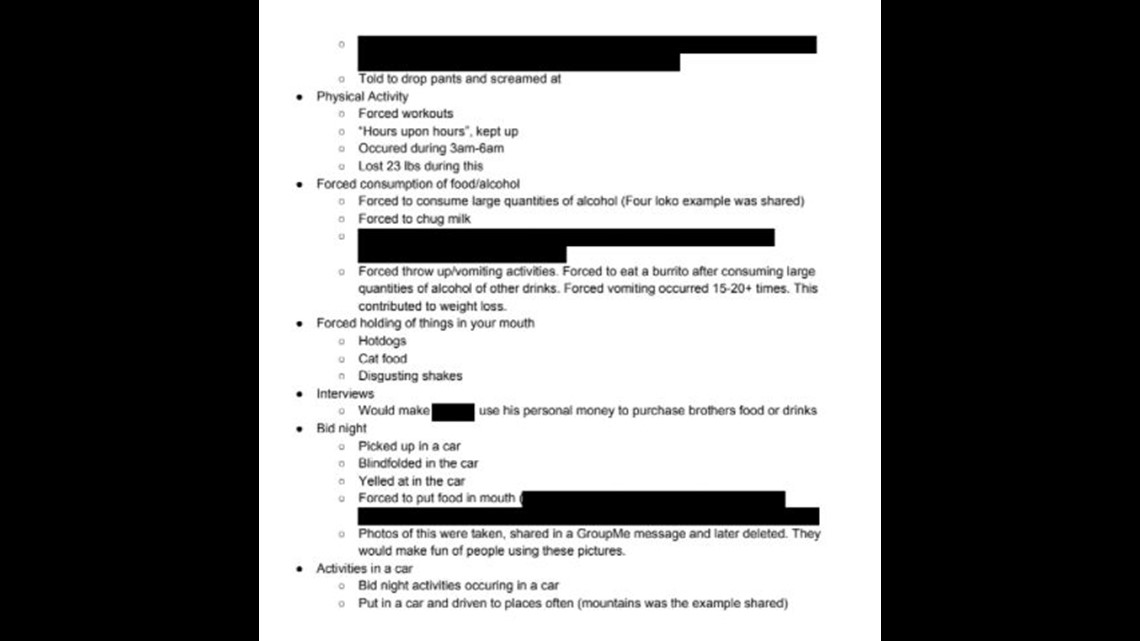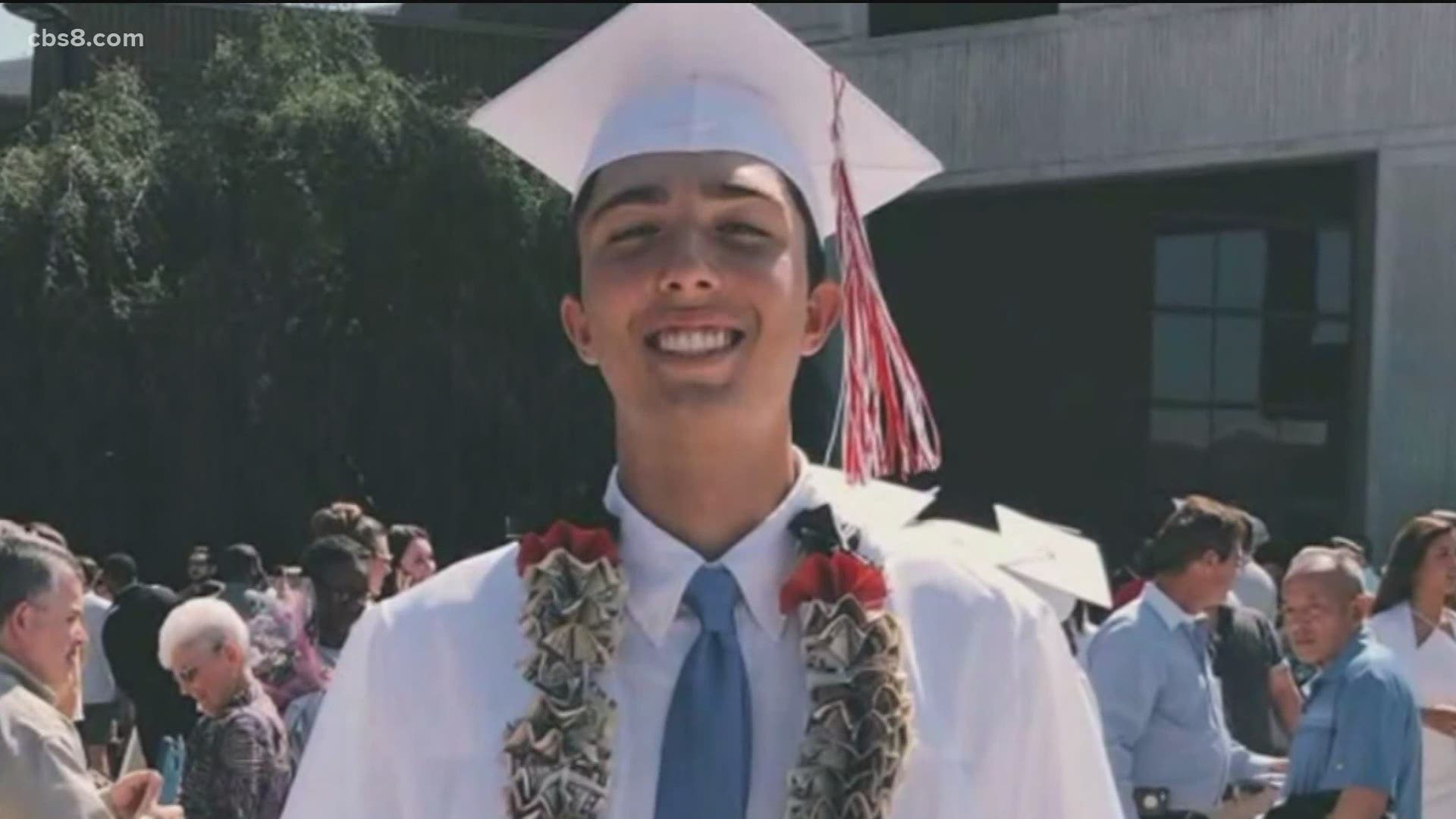SAN DIEGO COUNTY, Calif. — This is the second part of a News 8 investigation into fraternity misconduct at SDSU. To read the first part, click here.
Incidents of hazing, harassment and reports of party guests being drugged at fraternities within San Diego State’s Interfraternity Council organizations tell a rich history of misconduct among the organizations.
Timelines showcasing the years of this misconduct, obtained through public record, offer possibly the most detailed picture ever produced.
But hazing and fraternity pledge death is not exclusive to SDSU. Similar themes of hazing and fraternity misconduct ring nationwide.
News 8 spoke with three families who lost children to fraternity hazing in 2017. The parallels offer a similar tale to the death of Dylan Hernandez and some of the misconduct noted in SDSU's fraternities.
In order to compare, we must go back to 2017; one of the deadliest years in history to join a fraternity.
“If we had said no, that would have been the end of the discussion. He wasn’t one of those ‘but mom, but mom, but dad, but dad,’ if we had said no then the conversation would have been over.”
For Sandra Coffey, the hazing death of her son Andrew was a case that garnered national attention out of Florida State University.
Coffey’s death rang similar to Hernandez’s. They both surrounded the night of a big, little reveal night. The event where pledges meet their mentor within the fraternity. This is usually someone who has been an initiated fraternity brother for several semesters.
For Coffey’s fraternity of Pi Kappa Phi, the chapter undermined the liquor ban imposed by the university and misled pledges into drinking. This theme is common within SDSUs Interfraternity Council, whose chapters oftentimes proved to violate party bans and probations.
Both Coffey and Hernandez had only hours with their ‘older brother’ before dying.


There have been a total of 277 deaths from hazing incidents across colleges nationwide. For reference, the first hazing death was in 1838 where John B. Groves died at a seminary in Kentucky. From then until 2000, 177 people died from hazing-related incidents according to Hank Nuwer, a professor emeritus at Franklin College and an independent journalist who has studied hazing for the last four decades.
From 2000 to 2021, 100 people died from hazing.
Seven hazing deaths came in 2017.
Hazing incidents mostly gain attention when it involves a lawsuit related to the death of a fraternity pledge, namely, the case of Timothy Piazza in the spring of 2017.
Piazza was a pledge for Beta Theta Pi at Penn State University when he was hazed to death, fell down a set of stairs multiple times and suffered severe physical trauma to his head.
Doctors had to remove half his skull to relieve the pressure from his swollen brain caused by the head trauma.
His injuries were deemed unrecoverable and Piazza was pronounced dead on February 4, 2017. His blood alcohol content was estimated to be around 0.40% the night he was hazed.
Months before his death, when Piazza was looking to join a fraternity, he was searching for a fraternity that would not haze as hard as what happened to his roommate.
Evelyn Piazza, Tim’s mother, said Tim did not join an certain, unnamed fraternity because they took away his roommate’s phone. His roommate couldn’t set an alarm and then missed a final exam the next morning.
Jim Pizza, Tim’s father, said Beta Theta Pi wasn’t the first fraternity Tim tried joining either.
In his freshman year, Tim was at a rush event and attempted to introduce himself to a fraternity brother by offering a handshake, according to his father.
“Hi, I’m Tim Piazza,” Jim Piazza said. “And the guy said ‘Get the F out my face.’”
Tim Piazza was still set on joining a fraternity, according to his mom.
“He wanted to get in on his own merit,” Evelyn Piazza said. “He didn’t want somebody else to say ‘oh, I can get you into my fraternity.”
Tim Piazza eventually did join a fraternity.


While his death was not at the center of a big-little reveal night like Coffey’s, he suffered severe head trauma that was not treated until hours later, just like Dylan Hernandez.
Hernandez was escorted back to his Tenochca dorm room and helped onto the top bunk bed. He fell off the bunk bed and suffered a fractured skull at around 4:30 in the morning, around five hours after he stopped drinking. He did not receive medical aid until mid-morning when a young woman found him foaming at the mouth.
She said Hernandez was unresponsive and paramedics guided the young woman through CPR over the phone. When he was taken to Alvarado Hospital, the initial police report described his injuries as fatal. Hernandez was pronounced brain dead the next day.
The police report in Hernandez’s case estimated his BAC to be around .225% at its highest point. People close to Dylan told police he would come home heavily intoxicated more than once a week. One person told police, the night he suffered his fatal injuries, he appeared “more intoxicated during this incident than he did in those prior incidents.”
The hours between intoxication, injury and when medical assistance arrived is evident in Hernandez, Coffey and Piazza’s cases.
It also comes into play with the case of Max Gruver, a Phi Delta Theta pledge at Louisiana State University.
During a pledge event known as “Bible Study,” Gruver and his fellow pledges were coerced into hazing activities, including answering questions about Greek life and forced to drink if they got the wrong answer.
According to Rae Ann and Steve Gruver, Max’s parents, he and the pledges were doused in hot sauce and mustard, screamed at, forced to do wall-sits and placed in a room with little to no lighting.
These themes are similar to the hazing activities that went on in Theta Chi at SDSU in 2019 and with Phi Gamma Delta in 2017.
Max Gruver’s parents said he had to drink 190 proof alcohol, which led to his BAC estimated at .495% at the time of his death.
Rae Ann Gruver said they lucked out with the amount of info they were able to obtain in their son’s case.
“I think secrecy is a big thing,” Gruver said when talking about past fraternity hazing cases. “These boys, especially those pledges, stood up and immediately started saying what happened.”
Parents who have lost children to hazing have formed a strong network in the form of magazine publications, non-profit foundations and educational seminars.
The trauma from such a death is considered one of the most damaging.
“The loss of a child is definitely the ultimate tragedy,” said Dr. Dianna Gonzalez, a San Diego-based therapist who specializes in grief.
Dr. Gonzalez also told News 8 that she has treated students at SDSU who were hazed. She said that while most students won’t admit the hazing details, their symptoms align with other well-known hazing incidents.
“I think it’s one of those touchy subjects because they’re not supposed to speak about it,” Dr. Gonzalez said. “The way it comes up is through the symptoms they’re experiencing oftentimes it’s anxiety and depression and a lack of self esteem.”
Dr. Gonzales said it’s pivotal that parents sharing similar tragedies band together.
“It's sad that we know each other, but it's nice to have that connection because you know, other people, normal people may not understand that something so small might send you down a rabbit hole, but another parent who has lost a child this way will understand,” said Evelyn Piazza.
While the death of Dylan Hernandez has not been labeled a hazing death, the events surrounding his tragedy do mirror that of other students who have died from hazing.
This, in addition to the SDSU Police report that interviews several FIJI brothers admitting there was heavy drinking and paddling happening that night.
The heavy drinking and initiation process exhibited in FIJI also mirrors the violations reported at many other fraternities within the Interfraternity Council at SDSU, according to documents obtained by News 8.
But as thousands of students return to campus after a year of online learning, SDSU community members told News 8 they are worried for student safety.
For SDSU, it’s banking on reform to fraternity bylaws, transparency in its investigations and educational requirements to bring positive change to the Greek system this upcoming year.
But what do the documents show about SDSUs current investigation process?
The public records uncovered in this investigation list out a wide array of hazing instances that reportedly happened within SDSUs recognized fraternities.
From forced payments to forced drinking. From being blindfolded and driving in the back of a truck to sleep deprivation. The allegations and incidents confirmed by the school go into serious detail.
Much of that detail has never been published by SDSU, which just expanded its website to include investigative reports into its fraternities and sororities more than a year ago.
But fraternity investigations published by the university in the past hardly contain any specific details into the violations committed by fraternity brothers and their chapter compared to the documents obtained by News 8. In most cases, it’s hard to discern the severity of hazing reported or the context under which the violations were broken.
For example, the final published document in which SDSU suspended Theta Chi, Student Life and Leadership reported that Theta Chi’s hazing allegations included the following: “servitude, physical activity, forced consumption of alcohol, forced consumption of unusual substances, degradation, and I-Week activities.”
While this is true, the specific details known by the university were left out. This includes a firsthand account of an unknown student who was hazed while pledging Theta Chi.
He told the school that he was forced to drop his pants and was screamed at during his pledging.
The student, who’s name was redacted by the university to protect privacy, reported the physical activity included workouts from 3 a.m. to 6 a.m.
The same document reported this student was forced to throw up 15-20 times. He told the school he lost 23 pounds during the process.
He told the school that he “never felt so bullied in my life.”




The student’s mother was also interviewed and said her son called and “begged to come home,” adding that her son started to suffer from panic attacks.
Theta Chi was suspended by SDSU and had its chapter closed by the national Theta Chi in December 2019. Randy Timm, dean of students at SDSU, told News 8 that obtaining this level of detail in university fraternity investigations is rare.
“We get some vague information because people want to say, ‘hey, this is going on,’ but they don't want to make any identifiers as to who they might be,” Timm said. “We don't always get a level of detail.”
Caryl Montero Adams, who is the assistant dean of students for Student Life, Office of the Dean of Students and a co-chair on the recently established Presidential Task Force on Hazing Prevention, added that not adding specific details comes from an effort to preserve the privacy of a student.
“It would be case by case every situation, every case is unique,” Adams said. “As we're gathering information, determining how much detail to provide those types of things are things that we're evaluating.”
The amount of detail that the university provides in its fraternity investigations isn’t an exclusive issue to SDSU, but most universities whose fraternal misconduct is shown to the public will look at ways to change their transparency, according to Nuwer.
In the case of the University of Texas, Nicholas Cumberland’s hazing death was the catalyst for change in the university’s fraternal misconduct transparency.
The hazing reports page for the university has much more detail included compared to SDSU. For example, the chapter of Pi Kappa Phi at University of Texas was found to violate the hazing policies several times:
“New members: were made to engage in acts of servitude for active members, such as cleaning the house and giving rides to various locations; were driven around, some while having bags placed over their heads, by active members for hours while listening to disturbing, loud music; had to participate in calisthenics and line-ups; required to carry certain items with them; placed in a room in the house referred to as the "Hazement," a small room devoid of light, to complete line-ups and puzzles; were shot with airsoft guns; made to ingest gross/unwanted substances including laundry detergent, cat food, and ghost peppers; and subjected to interrogation by active members.”
Some of these hazing incidents mirror that of Theta Chi at SDSU, whose investigation details had to be obtained via public record laws. The hazing incidents in Texas were published publicly by the university.
Nuwer said SDSU must work to include this level of detail voluntarily if it wants to combat hazing. He said it’s a growing trend for schools to put more information out in the public rather than omitting the details.
“There is no excuse right now for any large greek system not to put each and every transgression, and we’re talking sexual assault, taking people to the hospital, when there’s a close call, all of that needs to be put on a page and shared with the public,” Nuwer said. “Even when SDSU says there’s a hazing incident, they’re trying to protect, I think, their own image, plus the students by not giving the details.”
Adams told News 8 that expanding the judicial reports website was part of the school’s effort to increase transparency.
“We are definitely wanting to provide additional information and that was one of our very specific efforts in order to do that,” Adams said.
The in-between year: SDSU cites the pandemic for slow rollout in hazing fixes
The judicial reports expansion mentioned by Adams was also recommended to the university by presidential task forces created days after Dylan’s death in November 2019.
The two task forces, known as the The Presidential Task Force on Student Activities and Safety and The Presidential Task Force on Alcohol and Substance Misuse, were primarily made of administrators and staff. Its goal was to address systemic issues within the university’s Greek system, clubs and sports campus wide.
Both task forces presented their findings in July 2020: 42 recommendations to be adopted in the short term and long term for SDSU clubs, Greek organizations and sports.
Out of the 42 recommendations, SDSU said it's fully implemented 16. Below is a list provided by SDSU that shows all the recommendations that are implemented, planned, in the works and considered a long-term goal.
Randy Timm told News 8 the pandemic held the university back from being able to fully implement more. He said the goal was to implement them with student input, and having school online this last year made it difficult.
“You're going to see more of those recommendations reviewed and put into place, but that's something that we have to do in conjunction with students and student organizations,” Timm said.
The Good Samaritan Policy was one of the first recommendations from the task forces to be adopted. It ensures that organizations who properly report medical emergencies/crises to emergency services and the university will not face disciplinary action.
With some exceptions in the case of severe or repeating violations, its intent is to entice more students to come forward with reports without fear of retaliation from their organization leaders.
The Good Samaritan Policy is not new, however. It existed within the Interfraternity Council for several years. Timm said the difference now is that the entire university has adopted the Good Samaritan Policy, not just for the IFC.
“This has been an opportunity for us to now publicize this, put it out more broadly and make sure that students are aware of the fact that ultimately we were concerned about you getting the help,” Timm said.
Money is also an issue for implementing the recommendations. In the Task Force on Alcohol and Substance Misuse, which made 17 recommendations, the task force members noted that fully implementing the proposals and maintaining them would cost around $529,300 annually.
They initially had just $39,813 in the current university budget to get it done. Members recommended shifting around other funds to offset the deficit.
Adams said while she can’t speak to the specifics of how much money is being directed, she said some of the money has already come to hire new positions.
“While some of that fiscal shuffling may be occurring, we want to acknowledge that there have been resources that have been dedicated to enhance these efforts,” Adams said.
This includes hiring a director for Fraternity and Sorority life as well as a new student life advisor to expand the Aztec Nights Program during weeks were more parties reportedly happen.
In an emailed statement to News 8, SDSU wrote that it will continue to implement task force recommendations going into the school year.
“Despite the ongoing COVID-19 pandemic, the work and implementation of these task force recommendations remains a priority,” the statement read, in part.
Anti-hazing experts and lawyers told News 8 the task forces do not address the root of the problem.
Nuwer said these task force recommendations were a good start but only scratched the surface of what he said needs to be fixed.
“I think the committee recommendations are a good start. But what's needed is a comprehensive independent review,” he said.
David Bianchi, a Florida attorney who handled the case of Andrew Coffey and championed state laws to make Florida hazing laws some of the strongest in the country, said that task forces are a good effort but do not work.
“We should support everyone who is working hard to stop hazing but, after 25 years of representing families across the country who have lost their sons to hazing, I am convinced that we need a radically different approach,” Bianchi said. “Commendable efforts like these have not worked.”
Bianchi is advocating for a zero tolerance policy, saying that if a student is injured or died from a hazing incident, every officer from the chapter would be expelled from the university.
“Every effort short of this is just nibbling around the edges of the problem and those efforts have not and will not work. Immediate expulsion is the only way to stop the scourge of hazing,” Bianchi said.
The Piazza family agreed.
“Things are just going to continue to happen but I can tell you once kids start getting tossed out of school and parents see that they're going to tell their own kids, ‘Hey, you better not get involved in any of that because I have been paying a lot of money for you to go to school,” Jim Piazza said.
Looking ahead: where IFC frats stand and where the school is standing up
As SDSU welcomes back thousands of students this fall, the current state of the Interfraternity Council remains in a period of relatively good standing with nationals and the university.
Below is a list of current and recently ousted IFC chapters and their current standing with the university.
Kappa Sigma: Unrecognized, suspended by the university but still chartered by the national chapter.
Pi Kappa Alpha: Good standing
Phi Delta Theta: Good standing
Sigma Phi Epsilon: Re-establishment period, unrecognized by the school but currently forming chapter.
Delta Sigma Phi: Good standing
Sigma Alpha Epsilon: This chapter is currently being investigated by the university. It’s been under a temporary suspension since September 16, 2020 but the reasons are unknown. News 8 has submitted a records request for the investigation documents and will update the story when more comes to light.
Phi Kappa Theta: Currently expelled from the university until 2024
Phi Gamma Delta: Chapter is closed nationally and expelled from the university until 2030
Theta Chi: Chapter is closed and suspended from the university until 2023
Sigma Chi: Good standing
Kappa Alpha Order: Good standing
Phi Kappa Psi: Suspended in Abeyance by SDSU until October 10, 2021
Delta Upsilon: Good standing
Zeta Beta Tau: Good standing
Alpha Epsilon Pi: Good standing
All chapters either declined comment, or did not respond to media requests over social media for News 8.
The incoming IFC President RJ Hullum, could not provide comment for this story.
University President Adela de la Torre, who originally suspended all IFC chapters after Dylan’s death, would not interview with News 8 but offered an emailed statement:
Higher education institutions across the nation must address the issue of hazing directly, and through a multi-level approach. At SDSU, the work of the task force groups I created follows decades of direct action to improve the lives and experiences of our students. Our work continues with new policies, training programs and accountability measures, all of which are meant to help our students live safely and have meaningful and successful experiences.
Randy Timm and Caryl Montero Adams told News 8 that some practices of controlling off-campus misconduct among university-affiliated individuals and organizations may carry over into the new school year.
SDSU clarified in a stated to say its currently reviewing exactly which policies will be used this term and that whatever it decides will be published online.
Part of this investigation sources The Daily Aztec for completing parts of the timelines. The Daily Aztec, which has been the SDSU paper of record for more than a hundred years, is welcoming a new editorial board this year and is spearheaded by Editor-in-Chief Catlan Nguyen.
Nguyen said that while she is proud of the historic fraternity coverage for The Daily Aztec, this year is different with a wave of students returning to campus.
“We can’t really know what is going to happen, it’s just preparing for the worst,” Nguyen said. “In terms of fraternities, I think they are going to have an influx of people.”
Nguyen said she believes the university has more work to do in order to prepare for the surge of students who may look to rush a greek chapter. She cited the coronavirus outbreaks in and around the college area, and parties that continued during the pandemic.
“It’s really sick but some people might think it’s cool that they’re going that hard… which is sad.”
READ: The full list of documents used in this investigation:
WATCH: Neighbors say SDSU off-campus parties are out of control during pandemic:

